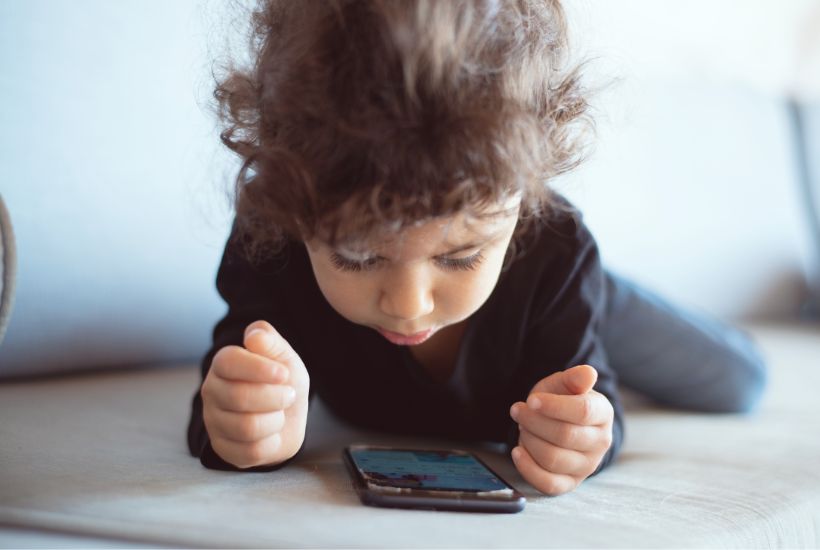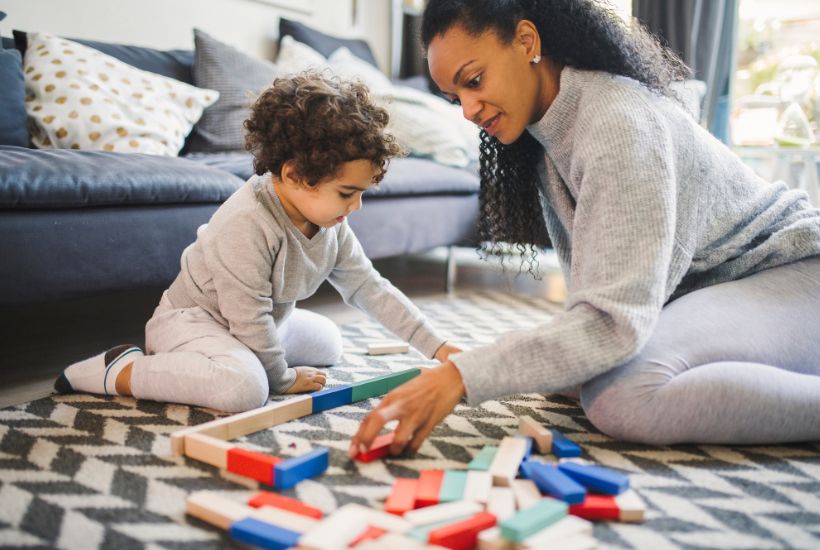How to Fight Screen Addiction: A Complete Parent Guide
In an age where technology is constantly evolving, it’s hard to keep up with the best ways to use screens without letting them take over our lives.
For children, this can be even more difficult.
They are growing up in a world where screens are everywhere and often necessary for schoolwork.
How do we, as parents, find the right balance? And when do we know that screen addiction has become a problem?
In this guide, we will explore all of these questions and more. We’ll discuss the effects of excessive screen time on children and adults, give tips on how to limit screen time, and offer advice on detoxing from too much screen time.
We’ll also touch on the importance of digital education and how to best approach it with your child.
So let’s get started!

Why are screens so hard to give up?
Screens are addicting for a variety of reasons. The first reason is that they provide a constant stream of stimulation.
Getting caught up in the never-ending cycle of checking social media, watching videos, and playing games is easy.
Another reason screens are so addictive is that they can be used as a form of escapism. When we’re feeling stressed or bored, it’s easy to turn to our screens to tune out the world around us.
Finally, screens can be addictive because they provide instant gratification. In addition, we often get rewards like likes, comments, and points when we use them, reinforcing the behavior.
The effects of too much screen time?
The effects of excessive screen time are wide-ranging and can be physical, social, cognitive, and mental.
Physical excessive screen effects
Too much screen time can lead to eye strain, neck and back pain, and headaches. It can also interfere with sleep, leading to fatigue and irritability.
Social excessive screen effects
When we spend too much time on screens, we can neglect our in-person relationships.
We lose our self-awareness and become wrapped up in our online personas. As a result, we might start to communicate differently, which can lead to conflict.
We might lose touch with friends and family members because it might feel like getting out of our comfort zone.
A lot of media usage takes up the time our children use to learn life skills and social skills are acquired.
Cognitive excessive screen effects
When we’re constantly staring at screens, we’re not giving our brains a chance to rest and recover.
Excessive screen time has been linked to attention problems, difficulty focusing, and poor academic performance.
It can also make it difficult to process information and think creatively, and it can also lead to impulsive behavior and make it difficult to control emotions.
Children might start to have trouble finishing tasks because they get easily distracted. Children might also find it harder to remember things they’ve seen or heard, affecting their working memory.
Mental excessive screen effects
Excessive screen time has been linked to anxiety, depression, and loneliness. It can also increase stress levels and trigger symptoms of ADHD.
When our children are constantly exposed to the bright light of screens, it can disrupt their body’s natural sleep cycle and lead to insomnia.
Anxiety can be caused by the constant stream of stimulation from screens and the pressure to be available online 24/seven.
Depression can set in when children compare their real lives to the curated version of reality that they see on social media.
It’s important to remember that what we see online is often a highlight reel and doesn’t represent someone’s entire life.
Loneliness can occur when children spend more time interacting with their screens than other people. They might start to feel like nobody understands them or that nobody cares.
How much screen time should kids have?
There is no one-size-fits-all answer to this question, as it depends on the child’s age and their individual needs. However, the American Academy of Pediatrics (AAP) recommends the following guidelines:
- Children under 18 months: Avoid the use of screen media other than video-chatting
- Children 18 to 24 months: Limit screen use to video-chatting and choose high-quality programming
- Children aged two to five years: Limit screen time to one hour per day of high-quality programming while co-viewing
- Children aged six and older: No more than two hours per day. Place consistent limits on the time spent using screens, make sure media does not take the place of adequate sleep or physical activity, and pay attention to the content to which children are exposed.
How to pay attention to the content your children are watching?
You should avoid anything too violent, gory, or sexually explicit. Instead, look for shows with positive messages and role models.
It’s also important to talk to your children about what they’re watching and help them understand how it might be different from real life.
I like to use commonsensemedia.org to help me pick appropriate movies and shows for my kids. They also have a great app that you can download to help monitor your child’s media usage.

How can you limit screen time?
There are a few things you can do to limit screen time:
1) set a family meeting to create a plan
Your child must understand what you are doing and why you are doing it.
Explain that you are concerned about how much time they spend on screens and that you want to help them find a balance.
2) Teach your child about the screen time recommendations for each age group
Tell them that the American Academy of Pediatrics recommends no more than two hours per day for children aged six and older.
Then, help them understand why this is important.
Explain that too much screen time can lead to attention, sleep, and mental health problems.
3) Let them help you come up with a plan
Once you’ve explained your reasoning, it’s time to brainstorm some solutions.
First, ask your child how they think you can limit screen time in the house.
This will help them feel like they are part of the solution, not just the problem.
Ask them how much screen time they think is appropriate each day and what activities they would like to do instead.
Then, work together to devise a plan you can all agree on.
4) Set Screen time rules
Once you have a plan, it’s important to set some rules.
For example, you might say that screens can only be used after homework is done or that there should be no screens at the dinner table.
Some families choose to have a tech-free day each week or to limit screen time to certain hours of the day.
Others might set a rule that screens must be turned off during dinner or family time.
It’s important to find what works best for your family and stick to it. It’s also important to make sure that everyone in the family is following the same rules, even yourself
5) Mealtime and bedtime are screen-free zones
Ensure your child’s bedroom is a screen-free zone at least 1 hour before bedtime.
This will help them wind down and prepare for sleep. It’s also important to have screen-free meals.
This is a great time to talk to your child about their day and connect with them on a deeper level.
Some great apps can help you limit screen time, such as Offtime, Moment, and Space if you have trouble sticking to these rules.
6) Set limits on specific apps or games
Apps and games are very addictive, so please be mindful of what apps and games your children use.
In our house, we don’t allow games, and we only allow educational apps until the age of 13. I think kids should be exposed to apps and games later when they can better understand the concept of time and limits.
I only allow just dance which is a PlayStation game, as it gets them up and dancing around, which is great exercise.
7) Charge electronics outside of the child’s bedroom
Another great tip is to charge all electronics outside your child’s bedroom.
This will help them stay away from screens when they are trying to sleep.
It’s also a good idea to keep screens out of the bedroom. This way, your child can create a space just for sleeping and relaxing.
8) Encourage outdoor activities and physical play
Make sure your child is getting enough physical activity. Please encourage them to play outside, go for walks, or ride bikes.
Physical activity is so important for overall health and well-being. It’s also a great way to reduce stress and improve mental health.
9) Help your child find a hobby.
Another great way to fight screen addiction is to help your child find a hobby. This can be anything from playing an instrument to painting to collecting coins.
Hobbies are a great way to encourage creative thinking and provide a sense of accomplishment.
They are also a great way to connect with your child on a deeper level.
So, take some time to explore different hobbies with your child and see what they are interested in.
10) Place screens in a public area in the house
Place your Tv and computer in a public area in your house, such as the living room or kitchen.
This will help you monitor your child’s screen time and what they are doing online. It’s also a great way to spend more time together as a family.
11) Keep communication open with your child.
It’s so important to keep communication open with your child about screen time and internet use.
Talk to them about the dangers of too much screen time and why it’s important to limit it.
Also, ask them how they feel about their screen usage and if they have any concerns.
Make sure they feel comfortable coming to you with any problems or questions they might have.
12) Model healthy behavior yourself
Finally, one of the most important things you can do is model healthy behavior yourself.
If you are constantly on your phone or computer, your child will think it’s okay for them to do the same.
So, make sure you are setting a good example for your child by limiting your own screen time.
How to educate your child about screen usage?
Educating your child about the dangers of too much screen time is important. Talk to them about limiting screen time and why it’s so important for their health.
Also, ask them how they feel about their screen usage and if they have any concerns.
Watch documentaries and movies together that teach about the dangers of screen addiction.
Some great ones are out there, such as Screenagers (ages 9+), The Social Dilemma (13+), and Screened Out (12+).
Take it one step at a time. Let your child have a dumbphone before they have a smartphone.
This way, they can still stay connected with their friends, but they won’t have access to social media or the internet.
You can also buy them a phone that doesn’t have any internet capabilities.
There are great options, such as the Nokia 225 and the Gabb Phone.
These phones are perfect for kids as they can only call and text people you approve of.
Finally, keep communication open with your child and let them know they can come to you with any problems or questions they might have.
Model healthy behavior yourself by limiting your own screen time. This will show your child that limiting screen time is important to living a healthy life.
A word about digital education
Please know that as a parent, you’ve had the time to process the mass media and how it seeped into our lives.
We didn’t have social media in our formative years. We played outside, got dirty, and had to use our imagination.
You might be thinking that this is all well and good, but what about digital education?
There’s no doubt that digital education has its benefits. But, there is such a thing as too much of a good thing.
Make sure your child’s school has a healthy online and offline learning balance.
Too much screen time can adversely affect children’s mental and physical health. So it’s important to find a balance that works for your family.
When should you buy your child a smartphone?
This is a difficult question, and there is no right or wrong answer. It really depends on your child and what you think they are ready for.
A good rule of thumb is waiting until they are in middle school.
This way, they have a better chance of understanding the responsibilities of having a smartphone.
If you decide to buy your child a smartphone, set some ground rules about screen time limits and internet usage.
It’s also important to keep communication open with your child about their phone usage.

When should your child use the internet?
Again, there is no right or wrong answer to this question. It really depends on your child and what you think they are ready for.
A good rule of thumb is to start with supervised internet usage and gradually allow them more unsupervised time as they age.
It’s also important to have regular conversations with your child about their internet usage and online activity.
This will help you keep tabs on what they are doing online and ensure they stay safe.
How do we do it with 3 different ages and stages?
I have 3 girls, ages 5, 8, and 13. Our house rules are that we watch a family movie on our family night. We have an ongoing list of movies we want to watch, and we choose from them every Friday.
And on Saturdays, my children watch 2 episodes of their favorite show, which are around 20 minutes each.
We don’t have screen time on weekdays.
As for our phone usage, each child is allowed to have a dumb phone by the age of 10 and a smartphone at the age of 12 but no social media till the age of 15.
I ask my kids questions like:
how do you think you benefit from not having social media or not having a phone?
How do you think it’s impacting your social life?
And what are some things you like about not having a phone?
I think these questions help them reflect on their screen usage and why we have the rules that we do in our house.
Thrive for balance, not minutes
Rather than stress about the minutes your child is watching TV or using the iPad, try to focus on balance.
A good rule of thumb is the 60/30/60 rule.
This means that your child should spend 60% of their day being active, 30% of their day doing things they enjoy, such as reading or playing outside, and only 60 minutes a day on screen time.
Of course, this is just a general guideline, and you will need to tailor it to your child’s individual needs.
But, it’s a great starting point for creating a healthy balance for your family.
You can also use this time chart to help you plan your child’s day.
Remember, it’s all about finding what works best for your family and creating healthy habits that will last a lifetime.
The bottom line
The bottom line is that parents need to control their child’s screen time. But, unfortunately, too much screen time can severely affect children’s health.
There are several things parents can do to fight screen addiction.
These include setting limits on screen time, placing screens in public areas, keeping communication open with your child, and modeling healthy behavior yourself.
Educate your child about the dangers of too much screen time and why it’s so important to limit it. The best way to do this is by leading by example.
So, make sure you are setting a good example for your child by limiting your own screen time. Show them that it’s possible to live a healthy life without being glued to a screen all day.
I hope these tips were helpful and that you can use them to fight screen addiction in your family.
Screen addiction is a real problem that is affecting more and more families. But, it’s important to remember that we can control our screens, and we don’t have to let them control us.
With a little effort and communication, we can lead healthier lives with less screen time.
I hope you found this information helpful, and please feel free to reach out if you have any questions.
I’m here to help! Ola xo.







